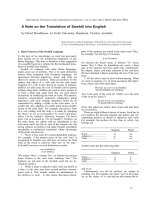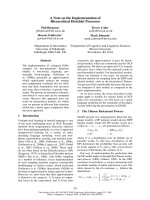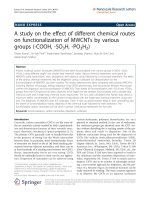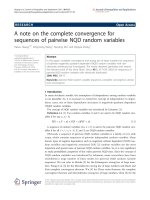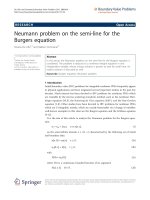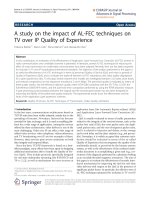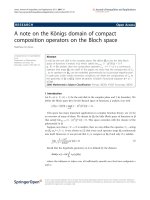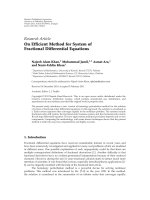Báo cáo hóa học: " A note on the complete convergence for arrays of dependent random variables" docx
Bạn đang xem bản rút gọn của tài liệu. Xem và tải ngay bản đầy đủ của tài liệu tại đây (215 KB, 8 trang )
RESEARC H Open Access
A note on the complete convergence for arrays
of dependent random variables
Soo Hak Sung
Correspondence:
Department of Applied
Mathematics, Pai Chai University,
Taejon 302-735, South Korea
Abstract
A complete convergence result for an array of rowwise independent mean zero
random variables was established by Kruglov et al. (2006). This result was partially
extended to negatively associated and negatively dependent mean zero random
variables by Chen et al. (2007) and Dehua et al. (2011), respectively. In this paper, we
obtain complete extended versions of Kruglov et al.
Mathematics Subject Classificat ion 60F15
Keywords: Complete convergence, Negatively associated random variables, Nega-
tively dependent random variables
1 Introduction
The concept of complete convergence was introduced by Hsu and Robbins [1]. A
sequence {X
n
, n ≥ 1} of random va riables is said to converge completely to the con-
stant θ if
∞
n
=1
P( |X
n
− θ| >) < ∞ for all >0
.
(1:1)
Hsu and Robbins [1] proved that the sequence of arithmetic means of i.i.d. random
var iables converges completely to the expected value if the variance of the summands
is finite. Erdös [2] proved the converse.
The result of Hsu-Robbins-Erdös has been generalized and extended in several direc-
tionsbymanyauthors.Sungetal.[3](seealso Hu et al. [4]) obtained the following
complete convergence theorem for arrays of rowwise independent random variables
{X
ni
,1≤ i ≤ k
n
, n ≥ 1}, where {k
n
, n ≥ 1 } is a sequence of positive integers.
Theorem 1.1.Let{X
ni
,1≤ i ≤ k
n
, n ≥ 1} be an array of rowwise independent ran-
dom variables and {a
n
, n ≥ 1} a sequence of nonnegative constants. Suppose that the
following conditions hold:
(i)
∞
n=1
a
n
k
n
i
=1
P( |X
ni
| >) <
∞
for all >0,
(ii) there exist J ≥ 2 and δ > 0 such that
∞
n=1
a
n
k
n
i=1
EX
2
ni
I(|X
ni
|≤δ)
J
< ∞
,
(1:2)
Sung Journal of Inequalities and Applications 2011, 2011:76
/>© 2011 Hak Su ng; licensee Springer. This is an Open Access article distributed under the terms of the Creative C ommons Attribution
License ( which p ermits unrestricted use, distribution, and reproduction in any medium,
provided the orig inal work is properly cited.
(iii)
k
n
i=1
EX
ni
I(|X
ni
|≤δ) →
0
as n ® ∞.
Then
∞
n=1
a
n
P( |
k
n
i=1
X
ni
| >) <
∞
for all >0.
Kruglov et al. [5] improved Theorem 1.1 as follows.
Theorem 1.2.Let{X
ni
,1≤ i ≤ k
n
, n ≥ 1} be an array of rowwise independent ran-
dom variables and {a
n
, n ≥ 1} a sequence of nonnegative constants. Suppose that the
following conditions hold:
(i)
∞
n=1
a
n
k
n
i=1
P( |X
ni
| >) <
∞
for all >0,
(ii) there exist J ≥ 1 and δ > 0 such that
∞
n=1
a
n
k
n
i=1
Var(X
ni
I(|X
ni
|≤δ))
J
< ∞
.
(1:3)
Then
∞
n
=1
a
n
P(max
1≤m≤k
n
|
m
i
=1
(X
ni
− EX
ni
I(|X
ni
|≤δ))| >) <
∞
for all >0.
When mean zero condition is imposed in Theorem 1.2, Kruglov et al. [5] established
the following result.
Theorem 1.3. Let {X
ni
,1≤ i ≤ k
n
, n ≥ 1} be an array of rowwise independent mean
zero random variables and {a
n
, n ≥ 1} a sequence of nonnegative constants. Suppose
that the following conditions hold:
(i)
∞
n=1
a
n
k
n
i=1
P( |X
ni
| >) <
∞
for all >0,
(ii) there exists J ≥ 1 such that
∞
n=1
a
n
k
n
i=1
EX
2
ni
J
< ∞
.
(1:4)
Then
∞
n
=1
a
n
P(max
1≤m≤k
n
|
m
i
=1
X
ni
| >) <
∞
for all >0.
The above complete convergence results for independent random variables have
been extended to dependent random variables by many authors.
The concept of negatively associated random variables was introduced by Alam and
Saxena [6] and carefully studied by Joag-Dev and Proschan [7]. A finite family of ran-
dom variables {X
i
,1≤ i ≤ n} is said to be nega tively associated if for every pair of dis-
joint subsets A and B of {1,2, , n},
Cov(f
1
(X
i
, i ∈ A), f
2
(X
j
, j ∈ B)) ≤
0
(1:5)
whenever f
1
and f
2
arecoordinatewiseincreasing(orcoordinatewisedecreasing),the
covariance exists. An infinite family of random variables is negatively associated if
every finite subfamily is negatively associated.
The conc ept of negatively dependent random variables was introduced by Lehmann
[8]. A finite family of random variables {X
i
,1≤ i ≤ n} is said to be negatively depen-
dent (or negatively orthant dependent) if the following two inequalities hold:
Sung Journal of Inequalities and Applications 2011, 2011:76
/>Page 2 of 8
P( X
1
≤ x
1
, , X
n
≤ x
n
) ≤
n
i=1
P( X
i
≤ x
i
)
,
P( X
1
> x
1
, , X
n
> x
n
) ≤
n
i
=1
P( X
i
> x
i
)
(1:6)
for all real numbers x
1
, , x
n
. An infinite family of random variables is negatively
dependent if every finite subfamily is negatively dependent.
Chen et al. [9] extended Theorem 1.2 to negatively associated random variables.
Theorem 1.4. Let {X
ni
,1≤ i ≤ k
n
, n ≥ 1} be an array of rowwise negatively associated
random variables and {a
n
, n ≥ 1} a sequence of nonnegative constants. Suppose that
the following conditions hold:
(i)
∞
n=1
a
n
k
n
i
=1
P( |X
ni
| >) <
∞
for all >0,
(ii) there exist J ≥ 1 and δ > 0 such that
∞
n=1
a
n
k
n
i=1
Var(X
ni
I(|X
ni
|≤δ))
J
< ∞
.
(1:7)
Then
∞
n
=1
a
n
P(max
1≤m≤k
n
|
m
i
=1
(X
ni
− EX
ni
I(|X
ni
|≤δ))| >) <
∞
for all >0.
When mean zero condition is imposed in Theorem 1.4, Chen et al. [9] obtained a
partially extended version of Theorem 1.3 for negatively associated random variables.
The partially extended version means that condition (iii) of Theorem 1.5 is added.
Theorem 1.5. Let {X
ni
,1≤ i ≤ k
n
, n ≥ 1} be an array of rowwise negatively associated
mean zero random variables and {a
n
, n ≥ 1} a sequence of nonnegative constants. Sup-
pose that the following conditions hold:
(i)
∞
n=1
a
n
k
n
i
=1
P( |X
ni
| >) <
∞
for all >0,
(ii) there exists J ≥ 1 such that
∞
n=1
a
n
k
n
i=1
EX
2
ni
J
< ∞
.
(1:8)
(iii)
k
n
i
=1
EX
2
ni
→
0
as n ®∞.
Then
∞
n
=1
a
n
P(max
1≤m≤k
n
|
m
i
=1
X
ni
| >) <
∞
for all >0.
Recently, Dehua et al. [10] obtained a version of Theorem 1.2 for negatively depen-
dent random variables.
Theorem 1.6.Let{X
ni
,1≤ i ≤ k
n
, n ≥ 1} be an array of rowwise negatively depen-
dent random variables and {a
n
, n ≥ 1} a sequence of nonnegative constants. Suppose
that the following conditions hold:
(i)
∞
n=1
a
n
k
n
i=1
P( |X
ni
| >) <
∞
for all >0,
Sung Journal of Inequalities and Applications 2011, 2011:76
/>Page 3 of 8
(ii) there exist J ≥ 1 and δ > 0 such that
∞
n=1
a
n
k
n
i=1
Var(X
ni
I(|X
ni
|≤δ))
J
< ∞
.
(1:9)
Then
∞
n=1
a
n
P( |
k
n
i
=1
(X
ni
− EX
ni
I(|X
ni
|≤δ))| >) <
∞
for all >0.
When mean zero condition is imposed in Theorem 1.6, Dehua et al. [10] established
a complete convergence result. However, the proof of Theorem 2 in Dehua et al. is
mistakenly based on the following relation.
k
n
i=1
(X
ni
I(|X
ni
| >δ) − EX
ni
I(|X
ni
| >δ))
>/2
⊂∪
k
n
i=1
(|X
ni
| >δ)
.
(1:10)
Note that the above relation is true only if
|
k
n
i
=1
EX
ni
I(|X
ni
| >δ)|≤/2
.
Chen et al. [9] and Dehua et al. [10] obtained complete convergence results (Theo-
rems 1.4 and 1 .6, respectively) for negative ly associated and negatively dependent ran-
dom variables and then they proved the case of mean zero by using these results.
However, this approach is not good. For the case of negatively associated mean zero,
an additional condition is assumed in Theorem 1.5. For the case of negatively depen-
dent mean zero, the proof is not correct.
In this paper, we obtain complete convergence results for negatively associated and
negatively dependent mean zero random variables. As corollaries of these results, we
can obtain Theorems 1.4 and 1.6.
2 Main results
In this section, we will establish complete convergence theorems for negatively asso-
ciated and negatively dependent mean zero random variables.
The f ollowing lemma is an exponential inequality for negatively d ependent random
variables which was proved by Dehua et al. [10] (see also Fakoor and Azarnoosh [11]).
Lemma 2.1.Let{X
i
,1≤ i ≤ n} be a sequen ce of negatively dependent random vari-
ables with EX
i
= 0 and
EX
2
i
<
∞
for 1 ≤ i ≤ n. Then, for any x > 0 and y >0,
P
n
i=1
X
i
> x
≤ 2P
max
1≤i≤n
|X
i
| > y
+ 2 exp(x/y)
1+
xy
n
i=1
EX
2
i
−x/y
.
(2:1)
The following lemma is an exponential inequality for negatively associated random
variables which was proved by Shao [12].
Lemma 2.2.Let{X
i
,1≤ i ≤ n} be a sequence of negatively associated random vari-
ables with EX
i
=0and
EX
2
i
<
∞
for 1 ≤ i ≤ n and let
B
n
=
n
i=1
EX
2
i
.
Then, for any x
> 0 and y >0,
P
max
1≤m≤n
m
i=1
X
i
> x
≤ 2P
max
1≤i≤n
|X
i
| > y
+ 4 exp
−
x
2
8B
n
+4
B
n
4
(
xy + B
n
)
x/(12y)
.
(2:2)
Lemma 2.3.Let{X
i
,1≤ i ≤ n} be a sequence of negatively associated random vari-
ables with EX
i
=0and
EX
2
i
<
∞
for 1 ≤ i ≤ n and let
B
n
=
n
i=1
EX
2
i
.
Then, for any x
Sung Journal of Inequalities and Applications 2011, 2011:76
/>Page 4 of 8
> 0 and y >0,
P
max
1≤m≤n
m
i=1
X
i
> x
≤ 2P
max
1≤i≤n
|X
i
| > y
+8
2B
n
3xy
x/(12y)
.
(2:3)
Proof. Since
e
−x
≤
1
1+
x
≤
1
x
for x > 0, we get that for x > 0 and y >0,
exp
−
x
2
8B
n
= exp
−
3xy
2B
n
x
/(
12y
)
≤
2B
n
3xy
x
/(
12y
)
.
(2:4)
We also get that
B
n
4
(
xy + B
n
)
x
/(
12y
)
≤
B
n
4xy
x
/(
12y
)
≤
2B
n
3xy
x
/(
12y
)
.
(2:5)
Hence, the result follows from Lemma 2.2. ■
Now, we state and prove one of our main results.
Theorem 2.4.Let{X
ni
,1≤ i ≤ k
n
, n ≥ 1} be an array of rowwise negatively depen-
dent random variables with EX
ni
=0and
EX
2
ni
< ∞
,
1 ≤ i ≤ k
n
, n ≥ 1. Let {a
n
, n ≥ 1}
be a sequence of nonnegative constants. Suppose that the following conditions hold:
(i)
∞
n=1
a
n
k
n
i
=1
P( |X
ni
| >) <
∞
for all >0,
(ii) there exists J ≥ 1 such that
∞
n=1
a
n
k
n
i=1
EX
2
ni
J
< ∞
.
(2:6)
Then
∞
n=1
a
n
P( |
k
n
i
=1
X
ni
| >) <
∞
for all >0.
Proof. By Lemma 2.1 with x = and y = /J, we have that
P
k
n
i=1
X
ni
>
≤ 2P
max
1≤i≤k
n
|X
ni
| >/J
+2e
J
1+
2
/J
k
n
i=1
EX
2
ni
−
J
≤ 2
k
n
i=1
P( |X
ni
| >/J)+2e
J
J
J
−2J
k
n
i=1
EX
2
ni
J
.
(2:7)
Hence, the result follows by conditions (i) and (ii). ■
Remark 2.5. A s noted in the Introduction, Dehua et al. [10] have proved Theorem
2.4, but their proof is not correct.
Theorem 2.6. Let {X
ni
,1≤ i ≤ k
n
, n ≥ 1} be an array of rowwise negatively associated
random variables with EX
ni
=0and
EX
2
ni
< ∞
,
1 ≤ i ≤ k
n
, n ≥ 1. Let {a
n
, n ≥ 1} be a
sequence of nonnegative constants. Suppose that the following conditions hold:
(i)
∞
n=1
a
n
k
n
i
=1
P( |X
ni
| >) <
∞
for all >0,
(ii) there exists J ≥ 1 such that
∞
n=1
a
n
k
n
i=1
EX
2
ni
J
< ∞
.
(2:8)
Sung Journal of Inequalities and Applications 2011, 2011:76
/>Page 5 of 8
Then
∞
n
=1
a
n
P(max
1≤m≤k
n
|
m
i
=1
X
ni
| >) <
∞
for all >0.
Proof. By Lemma 2.3 with x = and y = /(12J), we have that
P
max
1≤m≤k
n
m
i=1
X
ni
>
≤ 2P
max
1≤i≤k
n
|X
ni
| >/(12J)
+8
24J
3
2
J
k
n
i=1
EX
2
ni
J
≤ 2
k
n
i=1
P( |X
ni
| >/(12J)) + 8
J+1
J
J
−2J
k
n
i=1
EX
2
ni
J
.
(2:9)
Hence, the result follows by conditions (i) and (ii). ■
Remark 2.7. As noted in the Introduction, Chen et al. [9] have pr oved Theorem 2.6
under an additional condition (see also Theorem 1.5).
It can be proved Theorem 1.6 by using Theorem 2.4. But it is not easy to prove The-
orem 2.4 by using Theorem 1.6. So Theorem 2.4 is more general than Theorem 1.6.
Proof of Theorem 1.6. The set of all natural numbers is partitioned into two subsets
A
=
n :
k
n
i=1
P( |X
ni
| >δ) ≤ 1
, A
=
n :
k
n
i=1
P( |X
ni
| >δ) > 1
.
(2:10)
Applying (i), we obtain
n∈
A
a
n
≤
n∈
A
a
n
k
n
i
=1
P( |X
ni
| >δ) < ∞
.
(2:11)
Observing that
P
k
n
i=1
(X
ni
− EX
ni
I(|X
ni
|≤δ))
>
≤
k
n
i=1
P( |X
ni
| >δ)+P
k
n
i=1
(X
ni
I(|X
ni
|≤δ) − EX
ni
I(|X
ni
|≤δ))
>
,
(2:12)
it is enough to show that
I
1
=:
n∈A
a
n
P
k
n
i=1
(X
ni
I(|X
ni
|≤δ) − EX
ni
I(|X
ni
|≤δ))
>
< ∞
.
(2:13)
For 1 ≤ i ≤ k
n
and n ≥ 1, define
U
ni
= δI(X
ni
>δ)+X
ni
I(|X
ni
|≤δ) − δI(X
ni
< −δ)
,
U
ni
= δI(X
ni
>δ) − δI(X
ni
< −δ).
(2:14)
Then
I
1
≤
n∈A
a
n
P
k
n
i=1
(U
ni
− EU
ni
)
>/2
+
n∈A
a
n
P
k
n
i=1
(U
ni
− EU
ni
)
>/2
=: I
2
+ I
3
.
(2:15)
Sung Journal of Inequalities and Applications 2011, 2011:76
/>Page 6 of 8
For I
2
, we have by Markov’s inequality and (i) that
I
2
≤
4
n∈
A
a
n
k
n
i
=1
E|U
ni
| =
4δ
n∈
A
a
n
k
n
i
=1
P( |X
ni
| >δ) < ∞
.
(2:16)
For I
3
, we will apply Theorem 2.4 to random variable U
ni
- EU
ni
.Notethat{U
ni
-
EU
ni
,1≤ i ≤ k
n
, n ≥ 1} is an array of rowwise negatively dependent random variables
with mean zero and finite second moments. By the c
r
-inequality, we obtain that
n∈A
a
n
k
n
i=1
E(U
ni
− EU
ni
)
2
J
=
n∈A
a
n
k
n
i=1
E(X
ni
I(|X
ni
|≤δ) − EX
ni
I(|X
ni
|≤δ)+U
ni
− EU
ni
)
2
J
≤ 2
2J−1
n∈A
a
n
k
n
i=1
Var(X
ni
I(|X
ni
|≤δ))
J
+2
2J−1
n∈A
a
n
k
n
i=1
Var(U
ni
)
J
≤ 2
2J−1
n∈A
a
n
k
n
i=1
Var(X
ni
I(|X
ni
|≤δ))
J
+2
2J−1
δ
2J
n∈A
a
n
k
n
i=1
P(|X
ni
| >δ)
J
≤ 2
2J−1
n∈A
a
n
k
n
i=1
Var(X
ni
I(|X
ni
|≤δ))
J
+2
2J−1
δ
2J
n∈A
a
n
k
n
i=1
P(|X
ni
| >δ).
(2:17)
The last inequality follows by J ≥ 1 and the definition of A’. Hence, c ondition (ii) of
Theorem 2.4 holds.
Finally, it remains to show that condition (i) of Theorem 2.4 holds. That is,
n∈
A
a
n
k
n
i
=1
P( |U
ni
− EU
ni
| >) < ∞ for all >0
.
(2:18)
Let > 0 be given. Without loss of generality, we may assume that 0 < <4δ.For1
≤ i ≤ k
n
and n ≥ 1, define
X
ni
= X
ni
I(|X
ni
|≤/4),
X
ni
= δI(X
ni
>δ)+X
ni
I(/4 < |X
ni
|≤δ) − δI(X
ni
< −δ)
.
(2:19)
It follows that
k
n
i=1
P(|U
ni
− EU
ni
| >) ≤
k
n
i=1
P(|X
ni
− EX
ni
| >/2) +
k
n
i=1
P(|X
ni
− EX
ni
| >/2
)
=
k
n
i=1
P(|X
ni
− EX
ni
| >/2) ≤
4
k
n
i=1
E|X
ni
|
≤
4δ
k
n
i
=1
P(|X
ni
| >δ)+
4δ
k
n
i
=1
P(|X
ni
| >/4),
(2:20)
which entails that (2.18) holds by (i). Hence, the result is proved. ■
It can be proved Theorem 1.4 by using Theorem 2.6. But it is not easy to prove The-
orem 2.6 by using Theorem 1.4. So Theorem 2.6 is more general than Theorem 1.4.
Sung Journal of Inequalities and Applications 2011, 2011:76
/>Page 7 of 8
Proof of Theorem 1.4. Note that
P
max
1≤m≤k
n
m
i=1
(X
ni
− EX
ni
I(|X
ni
|≤δ))
>
≤
k
n
i=1
P( |X
ni
| >δ)
+ P
max
1≤m≤k
n
m
i=1
(X
ni
I(|X
ni
|≤δ) − EX
ni
I(|X
ni
|≤δ))
>
.
(2:21)
TherestoftheproofissameasthatofTheorem1.6exceptusingTheorem2.6
instead of Theorem 2.4 and is omitted. ■
Acknowledgments
The author would like to thank the referees for the helpful comments and suggestions. This research was supported
by Basic Science Research Program through the National Research Foundation of Korea (NRF) funded by the Ministry
of Education, Science and Technology (2010-0013131).
Competing interests
The author declares that they have no competing interests.
Received: 1 May 2011 Accepted: 5 October 2011 Published: 5 October 2011
References
1. Hsu, PL, Robbins, H: Complete convergence and the law of large numbers. Proc Nat Acad Sci USA. 33,25–31 (1947).
doi:10.1073/pnas.33.2.25
2. Erdös, P: On a theorem of Hsu and Robbins. Ann Math Stat. 20, 286–291 (1949). doi:10.1214/aoms/1177730037
3. Sung, SH, Volodin, AI, Hu, TC: More on complete convergence for arrays. Stat Probab Lett. 71, 303–311 (2005).
doi:10.1016/j.spl.2004.11.006
4. Hu, TC, Szynal, D, Volodin, A: A note on complete convergence for arrays. Stat Probab Lett. 38,27–31 (1998).
doi:10.1016/S0167-7152(98)00150-3
5. Kruglov, VM, Volodin, AI, Hu, TC: On complete convergence for arrays. Stat Probab Lett. 76, 1631–1640 (2006).
doi:10.1016/j.spl.2006.04.006
6. Alam, K, Saxena, KML: Positive dependence in multivariate distributions. Commun Stat Theor Meth. 10, 1183–1196
(1981). doi:10.1080/03610928108828102
7. Joag-Dev, K, Proschan, F: Negative association of random variables, with applications. Ann stat. 11 , 286–295 (1983).
doi:10.1214/aos/1176346079
8. Lehmann, EL: Some concepts of dependence. Ann Math Stat. 37, 1137–1153 (1966). doi:10.1214/aoms/1177699260
9. Chen, P, Hu, TC, Liu, X, Volodin, A: On complete convergence for arrays of rowwise negatively associated random
variables. Theor Probab Appl. 52, 393–397 (2007)
10. Dehua, Q, Chang, KC, Giuliano Antonini, R, Volodin, A: On the strong rates of convergence for arrays of rowwise
negatively dependent random variables. Stoch Anal Appl. 29, 375–385 (2011). doi:10.1080/07362994.2011.548683
11. Fakoor, V, Azarnoosh, HA: Probability inequalities for sums of negatively dependent random variables. Pak J Stat. 21,
257–264 (2005)
12. Shao, QM: A comparison theorem on moment inequalities between negatively associated and independent random
variables. J Theor Probab. 13, 343–356 (2000). doi:10.1023/A:1007849609234
doi:10.1186/1029-242X-2011-76
Cite this article as: Sung: A note on the complete convergence for arrays of dependent rand om variables.
Journal of Inequalities and Applications 2011 2011:76.
Sung Journal of Inequalities and Applications 2011, 2011:76
/>Page 8 of 8
